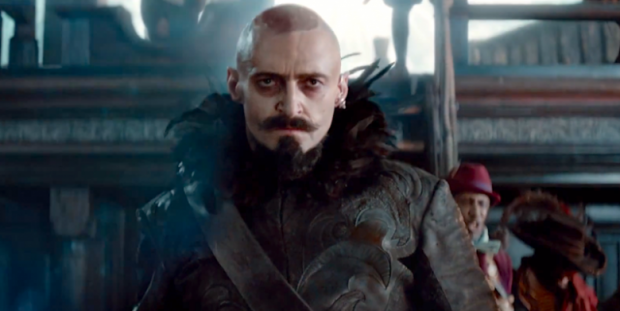The Peter Principle? Not Really: Pan
You want old-fashioned, uncomplicated, fulsome villainy in your fantasy-adventure movies? Look no further, my friend. Hugh Jackman’s elegantly honed emoting as a pirate king (unimaginatively) named Blackbeard in Joe Wright’s Pan is about all you could ask for: grand-scale evil performed with a wicked panache and a semi-camp sense of the ridiculous. Jackman’s pirate enters the movie singing a self-celebratory anthem accompanied by hundreds of imprisoned miners arrayed below him on a rocky cliff face, the scene looking something like a digitally exaggerated rendering of one of photographer Sebastião Salgado’s big, wide-angle pictures of South American laborers.
In the movie’s first half, Jackman is allowed some room to exercise his flair for archly hammy acting. (In effect, he’s supplying the functional equivalent of Captain Hook in J. M. Barrie’s classic Peter Pan, the inspiration for this picture.) Actually, it also has a Hook (Garrett Hedlund), but we needn’t go into that now. This is not Barrie’s Pan nor even Mr. Disney’s, but rather a major overhaul of the original. Some of the main characters are borrowed—Peter (Levi Miller), Hook, Tiger Lily (Rooney Mara)—but they’ve been reimagined and repurposed.
Peter is now a 12-year-old living in a London orphanage, having been abandoned there as an infant by his mother. It’s 1940, and above, at night, the Battle of Britain is being fought. Through a sequence of actions I’ll skip over, Peter finds himself on an airborne pirate ship perilously sailing amid the battling German bombers and British fighter planes. (This is the first spectacular use of the movie’s 3-D.) And then he’s deposited in Blackbeard’s mines, where he runs into one James Hook, another prisoner.
Thenceforth, Pan is increasingly a swiftly paced series of cartoonish hairbreadth escapes and big, loud battles between Peter and his crew and Blackbeard’s pirates. The two thematic elements involve the boy’s possible birthright as the little prince who can lead Neverland’s natives to freedom from Blackbeard’s violent, exploitive overlordship. I hope you’re not expecting me to elucidate the dense, barely clarified backstory. Maybe a 10-year-old—probably the intended audience member—could make sense of it all, but I couldn’t keep up with everything. I can tell you that the pirate has been mining life-extending “fairy dust” and needs to extend his increasingly unproductive operations into the natives’ territory. (You could probably draw an analogy to the post-Columbus colonial exploitation and despoliation of the America’s Indians, but, really, why try?)
Wright moves Pan along capably enough, but the movie takes its convolutions and bombast a little too seriously, though maybe not to those 10-year-olds. There’s some wise-guy repartee, a la Star Wars. What Pan lacks is the simple originality and charm of Barrie’s 1911 story. But it’s probable that the sentimental, twee side of the original wouldn’t work today. Nor would Barrie’s amused observation that children, like his ageless Peter, are “gay and innocent and heartless.” Our technically dominated, hard-edged world has its own kind of sentimentality.

